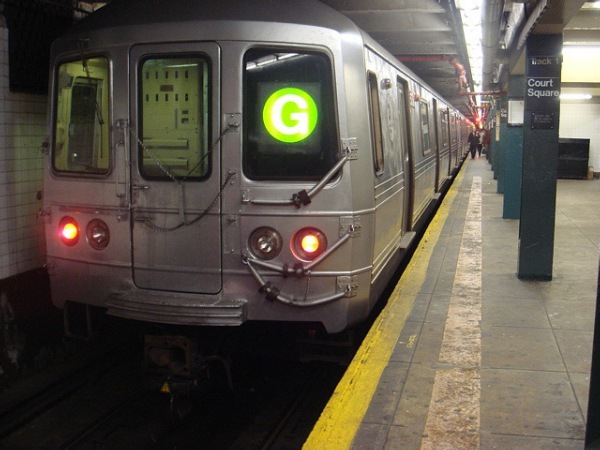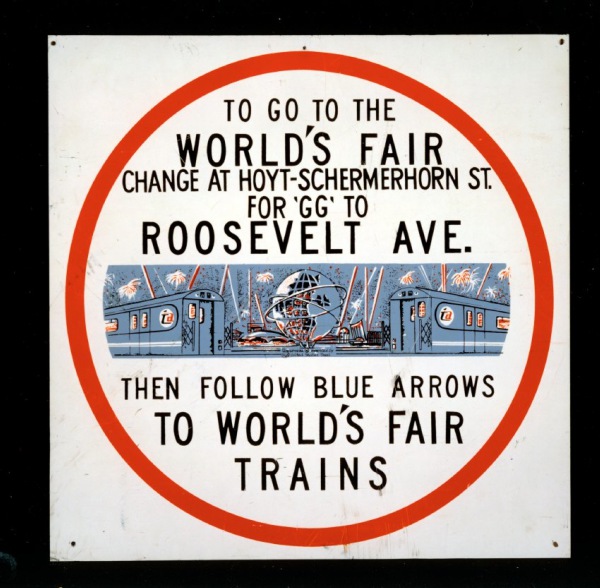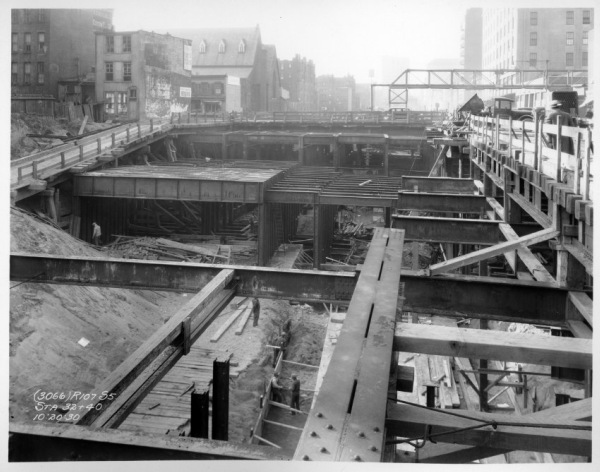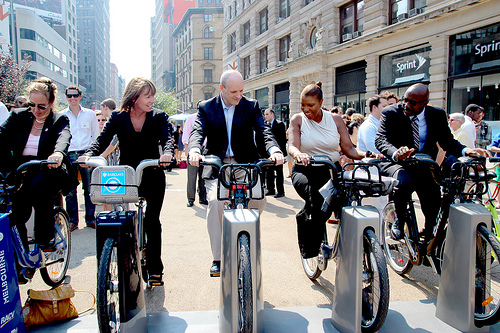Butt Of Jokes G Train Gets Some Serious Attention

NEW YORK — It was once known as the venerable train to the 1939 New York World's Fair and was a critical transit artery for workers at industrial plants churning out materials for World War II.
Today the G train is the object of jokes and rants each day, both for its small number of cars and its spotty service.
"It's a wild card as far as when I'll get to work or back home," said freelance theater director and Greenpoint resident Josh Hecht, who takes the G train daily and says he leaves home an extra twenty minutes or so early to get to work appointments.
A number of factors are coming together to bring change to the long-neglected G train, which has seen ridership grow because of the popularity of neighborhoods served by the subway line, including fashionable Williamsburg, Greenpoint, Fort Green, Clinton Hill and Bedford-Stuyvesant in Brooklyn.
The Metropolitan Transportation Agency, in response to calls from state lawmakers and a new transit advocacy organization for improvements like increased frequency of trains and communication with riders on the line, has announced that it will do a so-called "full line review" of the line by June. That review could result in major upgrades to one of the city's most neglected lines.
Reviews of the L and F lines have led to improvements in service in recent years.

Of course, it remains to be seen whether the MTA can find any room in its already squeezed budget for improvements, especially after Hurricane Sandy caused an estimated $5 billion in damage. A spokesman for the state comptroller's office said it expected the storm to "have a relatively small budget impact" on the MTA.
"We're asking the MTA to partner with riders to make some common-sense improvements to G train service," said John Raskin, CEO at Riders Alliance, a new grassroots organization that seeks increase funding for public transit in New York overall. The group is taking a neighborhood-by-neighborhood approach, with the G train being its current focus.
Raskin said MTA service cuts in 2010 to the entire subway system had focused attention on the G line's inadequacy.
"The MTA doesn't have the resources it needs to fully run the subway system — the G train being just one example of that greater system-wide problem of inadequate funds," Raskin said.
But he says that many of the changes being called for by his group and others for the G involve simple reprogramming of existing services that could come at little cost.
MTA spokesman Aaron Donovan told the Gotham Gazette that the agency "continuously evaluates levels of ridership, including loading levels, boardings and alightings, across all subway and bus lines, and seeks to maximize service availability to as many customers as possible within operational, capacity and financial constraints."
State Sens. Daniel Squadron and Martin Malavé Dilan are among the lawmakers whom support improving service on the line. A Squadron spokeswoman, Amy Spitalnick, says the the full line review would compile thorough information on rider patterns, find out where and when there are service gaps and figure out where service can be filled in at a very cost effective way-even in a day of constrained budgets.
The data that already exists helps create a compelling picture of a subway line that is becoming more in demand as the neighborhoods it serves increase in popularity.

At subway stops served by only the G and no other trains, ridership is up year over year, based on percentage. For example, MTA data shows that ridership spiked by 13.2 percent at Greenpoint Avenue between 2010 and 2011; by 12.7 percent at Nassau; and by 11.3 percent at Flushing Avenue.
Real estate agents also report an increased interest in the neighborhoods served by the G line. According to PropertyShark.com, home prices in Williamsburg shot up 174 percent between 2004 and 2012. In the areas north of Williamsburg, such as Greenpoint, prices were up by as much as 47 percent.
Real estate players consider reliable train service an important factor when making decisions about where to build.
"People forget that it was the subways and elevated train lines of years ago that led to development in places like the Bronx allowing immigrants who before that were crowded into lower east side tenements to move to bigger apartments," said Marcia Rose Yawitz, a 40-year real estate veteran and current senior director and principal at Eastern Consolidated.
Anthony Lolli, CEO of Rapid Realty, one of the city's largest residential brokerages, said that just a few years ago, if a broker told a client that an apartment was off the G train, they groaned.
"While that's still a common attitude, now we have a growing number of renters who specifically want to live along the G. The housing options along that line have become so good," he said.
For most of its history, the G train — originally known as the GG — operated between 71st Ave in Forest Hills Queens and Church Ave., in Brooklyn. Soon after it opened 1937, the line was cut back to Smith and Ninth Street in Brooklyn. It quickly gained fame as the best way for Brooklynites and Queens residents to get to one of the nation's biggest events — the 1939 World's Fair at Flushing Meadows-Corona Park via an extension built from the Forest Hills station (and later closed in 1940). From the 1940s, the GG was a workhorse line for industry-heavy northern Brooklyn.
But then the cuts began, and the GG shrunk. Currently, it runs between Court Square in Queens and Church Avenue in Brooklyn.
"The G train is one of those unsung heroes," said transit historian Andrew Sparberg. "It performs a vital function, but it doesn't do so under the bright lights of Manhattan. But for the people of Brooklyn and Queens who have used it over the years and now use it each day, it's a very important train."
For those who don't know the G, it is the only train option for trips between central Brooklyn and at one time, central Queens and is the only line between the boroughs that doesn't actually go through Manhattan.
Sparberg, who teaches courses on subway history at the New York City Transit Museum, said the G train plays a supporting role to other, more critical lines in the system. "The G's biggest role over the years was that of a strictly local line," said Sparberg.
.
In many ways, the G line is still playing that role.
On the other side of Brooklyn, south where the G extended service to Church Street, one rider sang some of the G's praises.
Mitch Adair, a marketing advertising and brand consultant, says he thinks the G and its reputation as a 'forgotten train' could be remedied with a few tweaks, perhaps those called for by the Riders Alliance and others. But for now, Adair is happy with his ability to keep things on his side of the river and avoid Manhattan when crossing over into Queens.
"I can't tell you how nice it is to live in Brooklyn and get to PS1 in Queens without a trip through Manhattan," he said, referring to the outpost of the Museum of Modern Art that is a hipster haven of sorts. "What a relief!"
____
Image of G train at Court Square courtesy of Bitch Cakes, used under Creative Commons license. Images of G train poster from the 1939 New York World's Fair and from construction of the line courtesy of the New York Transit Museum.
Why The Latest Delay To The Bike Share Program May Not Be The Last

NEW YORK — The latest delay of the city's bike share program is being blamed on damage caused to equipment by the floodwaters of Superstorm Sandy.
The bike share will now launch in May 2013, with 5,500 bikes instead of 10,000 as initially planned, the city's Department of Transportation said in a news release Friday. The bikes will now roll out first "in the densest and most geographically contiguous parts of the service area" of Manhattan and Brooklyn.
Citi Bike Share, as it is known, failed to launch this past summer as expected because of software glitches.
And while the program appears to be lurching forward, there are signs that the Candian-based sole supplier of bikes and technology for the bike share, known as Bixi, is in financial trouble and is straining to meet its obligations in other U.S. cities.
Recently put up for sale, the company and its U.S. partner, Alta Bicycle Share, have been incapable of delivering 54 new bike stations for the expansion of the Washington, D.C., program, according to The Washington Post. There are also delays with the launch of Bixi-based systems in Chicago and San Francisco, though not necessarily because of difficulty obtaining equipment.
Alta Bicycle Share was also picked to oversee New York City's bike share.
The delays — coupled with the culture of secrecy by company and city officials regarding details about the program's launch — have added to the frustrations of cyclists as well as critics who say that despite the Canadian supplier's financial woes, Alta appeared to be a shoo-in for the New York City program.
Meanwhile, critics of how the city has handled the bike share program are questioning whether Alta has adequate insurance to cover the damage to the equipment caused by Sandy.
"I'd say expect more delay and more shrinkage of scope," said Norman Steisel, a former deputy mayor under David Dinkins who has sued the city over a bike lane in Brooklyn but supports the idea of bike shares. "Given its problem-plagued history to date in New York City and elsewhere, Alta has proved itself to be unqualified to carry out the program." He said that "sufficient grounds exist to declare the firm in default."
"This important and highly desirable restructuring of our street network should be started over — this time with proper legally required input of the City Council by exercise of its franchise granting authority," said the government policy expert in an email to Gotham Gazette.
(Steisel has earned the ire of many in today's cycling advocacy community, because of his vocal opposition to an additional bike lane in Brooklyn's Prospect Park – but he told Gotham Gazette that he thinks bike shares and lanes are "all fabulous ideas," but doesn't agree how they've been implemented.)
Alta is listed in the official contract as the sole owner of the New York City Bike share or NYCBS. According to the city's contract, if the city has reason to believe the bike share contractor is in poor fiscal health, and that that the financial woes might impact its ability to perform its duties, DOT can request a full accounting of its finances.
For the record, Alta has fiercly maintained an official separate identity as a company apart from Bixi or the publicly-funded PBSC.
But since PBSC/Bixi is the exclusive supplier of bikes and technology for Alta, it stands to reason that if there is no PBSC/Bixi, then Alta will certainly be facing an existential crisis.
As recently as this past fall, Bixi announced that it did not bring in the revenue it had projected for this past year. Its deficit was due to delays in getting the bike-share programs up and running in cities like New York, according to the Montreal auditor general's office.
New York City's Department of Transportation did not respond to questions about whether the bike share has sufficient insurance to cover damage to the equipment or whether the financial troubles facing Bixi might be a cause for concern.
Bixi spokesman Michel Philibert said the Canadian company had no comment . He instead referred all questions to Alta, which has not responded to repeated requests for comment from Gotham Gazette since the bike share was delayed this past summer.
In previous comments to Gotham Gazette before Friday's announcement of the new delay, Seth Solomonow, a spokesman for the DOT, said the bike share would someday bring New Yorkers a new, affordable transportation option at no cost to taxpayers and with profits shared with the city — emphasizing that the structure of the deal guarantees that there will be no city outlay to support the system.
On Friday, the DOT said Sandy's storm surge in late October flooded Brooklyn's Navy Yard, where "two-thirds" of the bike share's equipment was being stored, causing damage to bike frames and hardware.
“Despite the damage, New York will have the nation’s largest bike share system up and running this spring," said DOT Commissioner Janette Sadik-Khan, in a statement.
Andrew Brent, a spokesman for the main corporate sponsor, Citi Bank, said Friday that they were still committed to the New York City program in spite of the delays.
LACK OF TRANSPARENCY
Much of the outcry about the delays with the eagerly awaited program has been due to a dearth of information about its progress coming from either DOT officials or the various companies involved in its stewardship.
But the concerns about transparency are not just in New York City. In Montreal, city officials there are also frustrated about the lack of information about how the Bixi program — and, thus, Montreal taxpayers — benefits from its international activities.
"The whole Bixi adventure has been characterized by a lack of transparency. There have been transparency issues with both the administration of the local arm and the administration of the program in other cities," said Sarah Gagnon-Turcotte, political operative for City Councilor Louise Harel, cabinet of the chief opposition party in Montreal.
Turcotte, who is in charge of the Bixi probe, said she did not know how far along BIXI was in the sale process. But she said that the contract binding BIXI and Alta "could be part" of any sale.
Turcotte said they hadn't been able to obtain information on the consolidated activities of PBSC in Montreal and other cities and how it impacts the local organization that is backed with Montrealers’ money.
"We have been very vocal on this front, but it seems to be part of the culture of the party in power," she said, referring to the administration of former Mayor Gerald Tremblay, who resigned Nov. 5, following allegations of corruption. Tremblay had been Bixi's biggest booster.
A FORECAST FINANCIAL STORM
There were plenty of red flags about the financial situation facing Bixi for any official in New York City to weigh into any decision regarding giving Bixi's U.S. partner, Alta, the concession.
A 2011 report from the City of Montreal's auditor general brought to light the fact that the city of Montreal was not in conformity with Quebec law, which states that a city can't be using public money for commercial activity — which it has done in several cities with the bike share.
Montreal's municipal auditor report also said that Bixi had launched without a comprehensive business plan employing “questionable accounting treatments,” and had “neglected” rules of management.
Later, when a rescue plan of $108 million was designed in which the city of Montreal would lend $35 million to Bixi, Quebec's government demanded first that the city follow the auditor's recommendation and make sure it was in conformity with the law. It wasn’t clear at the time, but a sale was just an option, not an obligation in itself.
That point had since been clarified before the sale process began. Regardless, the city has gone ahead anyway and requested PBSC to sell its international arm.
PBSC/Bixi is also being sued by a software company that had developed the original software that ran its payment terminals, solar energy control and other elements of the bike share systems it sold to cities in theU.S. PBSC/Bixi ditched the software company and began to develop its own solutions from the ground up, which contributed to the delay in New York City.
Former Montreal Mayor Tremblay had maintained his support for keeping the international arm, saying in a press release this past June that "international activities such as New York and other US cities finance the local bike-share system in Montreal."
The May 2011 financial package that the City of Montreal had put together included a $37 million loan with $71 million in loan and credit-line guarantees to expand the international arm in places such as New York. At the same time, the Canadian press was having a field day reporting on financial troubles facing Alta's supplier.
HOW WAS ALTA PICKED FOR NYC'S BIKE SHARE?
According to language in the New York bike share RFP, initial proposals were evaluated by an evaluation committee. That committee was assisted by technical advisors who may have included representatives from other city agencies and public entities.
The technical evaluation accounted for the initial ranking, which narrowed all the bidders down to three companies who were then shortlisted for further evaluation of their business models.
At 35 percent, "demonstrated financial capability" was the single biggest determining factor for the short list, followed by proposed levels of investment to capitalize the system; value of the system services provided to the public; and the amount of revenue offered to the city.
Ross Sandler, director for the Center for New York City Law at the New York Law School, (who has not read and is not familiar with the the bike share RFP or contract) explained that the term "demonstrated financial capability" is simply a legal term of art. It basically means the bidding company needs to be able to fulfill the terms of the contract. He said the city can ask for whatever it wants to determine a competing bidder company's financial health.
"That bidder has to demonstrate that it's responsible," Sandler said. "One of the aspects of being responsible is having the financial wherewithall to carry out the contract."
But, he said the decision about whether a bidder is responsible is within the city's discretion. Sandler explained that there are a wide range of factors the city can look at when making that determination, including its past performance.
In September 2011, the city's DOT named Alta the vendor for what was set to be the nation's largest bike share program.
____
Cody Lyon is an avid New York City cyclist and freelance journalist for TechPresident, Wine Enthusiast, the Real Deal and the Biz Journals.
How The City Council Plans to Rein In the 'Wild West' of Pedicabs: A Policy Brief

NEW YORK — Too many tourists are being taken for a ride by pedicab drivers charging excessive fees, city officials say.
After one vacationing couple made tabloid headlines for being scammed into paying over $400 for a 12-minute pedicab ride, City Council members introduced a bill aimed at stopping such exorbitant fees. The new bill is on its way to being voted on by the City Council at tomorrow's stated meeting.
While the case of the $400 pedicab ride is extreme, the bill's sponsor, Councilman Dan Garodnick, said today at a committee hearing that the "outrageous fares" are not uncommon throughout Central Park and Times Square, an area he calls "Mid-town's Wild West." Tourists often begin a pedicab ride with the expectation of paying $30 to $40, when at the finish they end up paying anywhere from $90 to $15, he said.
The bill calls for making it impossible for pedicab drivers to stack on any added fees.
CONTEXT
Intro. 0597 - 2011 is part of an amendment to a local law to the administrative code of the city of New York and was debated in the Committee on Consumer Affairs. It is designed to eliminate confusing pedicab rates and fees and to simplify what the committee's chair, Garodnick, describes as having become "predatory business practices."
HOW IT WILL AFFECT NEW YORKERS
This bill aims to make it mandatory for pedicab drivers to use a timer during all rides, fastened within clear view of the passengers. It would also require that pedicabs charge a per minute rate only and to post the rate on the side of the pedicab.
Information cards must be supplied to all passengers listing the per minute rate, along with the name and license number of the pedicab driver as well. There will be no more hidden fees, surcharges, taxes, or mandatory gratuity added on to the final cost.
WHO DID WHAT?
The bill is being sponsored by Garodnick and is backed by the city council committee on consumer affairs, including city Councilman Charles Barron and Councilwoman Julissa Ferreras.
Councilman G. Oliver Koppell said he believes the issue would be better handled under the NYC Taxi and Limousine Commission, as pedicabs are now to be priced the same way regular taxicabs are.
The New York City Pedicab Owners' Association has endorsed the bill, saying it will help the sector to maintain a good reputation.
The Department of Consumer Affairs, which would be responsible for developing a "pedicab information card" that would display basic consumer protection information, has supported the bill.
NEXT STEPS
The bill was approved at today's committee meeting and goes to the full Council hearing tomorrow.
REFERENCE
View Intro. 0597 - 2011 Legislation Text and Details
Committee on Consumer Affairs report on pedicab fares, Nov. 26, 2012
____
Image by Kevin H., used under Creative Commons license.




